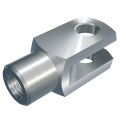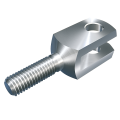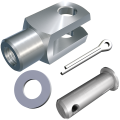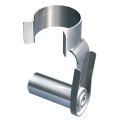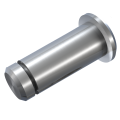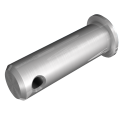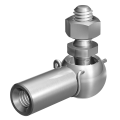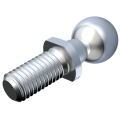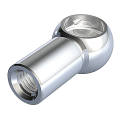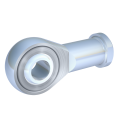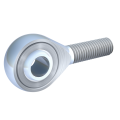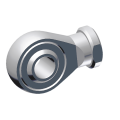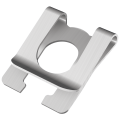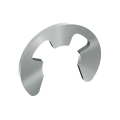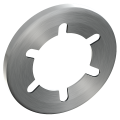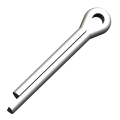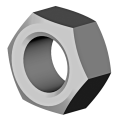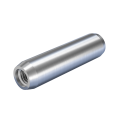1. Product description
Parallel pins with female thread according to DIN EN ISO 8735 are precisely manufactured linking elements used for force-fit and positionally secure connections of components, allowing for precise positioning and fixation. They consist of a cylindrical body with internal threads and are available in various sizes and materials. Due to their high dimensional accuracy, they are especially suitable for applications that need to be solved rarely or never. The internal thread of the parallel pins provides additional fastening potential by allowing the insertion of threaded pins or screws. This makes them even safer and more versatile for use in various industrial applications.
2. Product details
Size: A 6 x 16 - B 50 x 200
Material group: Steel, stainless steel
Surface: bright, surface roughness Ra ≤ 0,8 µm
d Diameter: 6 - 50
l Length: 16 - 200
d2 Thread: M4 x 0,7 - M24 x 3
t1 Thread length: 6 - 36
t2 min. Depth of the thread: 10 - 50
3. Application Areas & Compatibility
Mechanical engineering: Parallel pins with female thread are primarily used for the precise positioning of machine parts. They help to align components accurately and fix them securely.
Toolmaking: In toolmaking, these pins act as reliable fixing elements for cutting tools and precision tools. They ensure repeatable and exact handling.
Plant engineering: Here, parallel pins with female thread provide secure and robust connections of parts. They are designed to withstand high mechanical loads.
Precision engineering: In precision engineering, these pins are indispensable in the manufacturing and maintenance of precision mechanical devices. Their precision and reliability are of utmost importance.
Compatibility
Thanks to the standardized dimensions according to DIN EN ISO 8735, parallel pins with female thread are compatible with other standard parts and assembly components. This facilitates the exchange and integration into existing systems and allows for flexible adaptation to different assemblies and projects.
4. Advantages and Benefits
Precision: Parallel pins with female thread offer high dimensional accuracy, which is essential for the precise positioning of components. This accuracy ensures that the components are perfectly aligned, thereby guaranteeing the flawless function of the entire assembly.
Versatility: These pins are suitable for a wide range of industrial applications. They can be used in fields such as mechanical engineering, tool manufacturing, plant construction, and precision mechanics. This versatility makes them an indispensable part of numerous production processes.
Durability: Made from high-quality hardened materials like steel and stainless steel, parallel pins with female thread are characterized by their high load capacity and longevity. This durability ensures that the pins perform reliably even under demanding conditions and frequent use.
Additional Function – female thread: The female thread of the parallel pins provides expanded mounting options. It allows the screwing in of threaded studs or screws, offering additional fixing possibilities and a more secure fastening of components. This additional function significantly expands the application range of the pins, making them a flexible solution for various use cases.
Due to these special properties and functions, parallel pins with female thread offer numerous advantages, making them a crucial element in industrial manufacturing and assembly.
5. Assembly and Installation
Step 1 - Preparation of the bore: Before the parallel pin with female thread is mounted, it is essential that the bore is clean and free of burrs. This ensures that the pin can be inserted accurately and a secure connection is guaranteed. Dirt and burrs in the bore can hinder the assembly and affect the stability of the connection.
Step 2 - Pressing or driving in: The actual assembly is done by pressing or driving the parallel pin into the prepared bore. It is important to apply even pressure to avoid damage. This ensures a stable and permanent fixation of the pin in the component.
Step 3 - Using the female thread: After the assembly, the integrated female thread can be used for additional securing. Screws or threaded pins can be screwed in to further stabilize the connection and secure the fastening. This additional fixation increases the reliability and load-bearing capacity of the entire construction.
A clean and careful assembly step ensures that the parallel pin with female thread can achieve its full functionality and strength. Using the female thread provides an additional method for stabilizing and fixing the components, making the application possibilities even more diverse.
Step 4 - Inspection and testing: After the assembly, it is crucial to inspect the installation to ensure that the fit and alignment of the components meet the specifications. A thorough inspection helps to identify and correct assembly errors before the assembly is put into operation.
6. Safety instructions & Standards
Protective equipment: During the assembly of parallel pins with female thread, wearing appropriate protective equipment is essential. Safety goggles protect the eyes from flying particles and shavings, while gloves protect the hands from injuries and skin irritations. These precautions significantly contribute to preventing workplace accidents.
Tools: Use only intact and task-appropriate tools. Defective or unsuitable tools can lead to faulty assemblies and injuries. Additionally, suitable tools ensure a safe, precise, and efficient installation of the parallel pins.
Compliance with standards: When assembling and using parallel pins with female thread, it is crucial to observe the relevant standards. Adherence to DIN EN ISO 8735 is particularly important. This standard outlines the requirements for parallel pins that must be met for safe and reliable use. Furthermore, supplementary engineering and safety standards should be considered to ensure the highest safety and quality standards.
Overview of various standards: The hardened parallel pins are found in DIN EN ISO 8734, previously DIN 6325. Another hardened version with additional female thread is standardized in DIN EN ISO 8735. Unhardened versions are standardized according to DIN EN ISO 2338, previously DIN 7.

